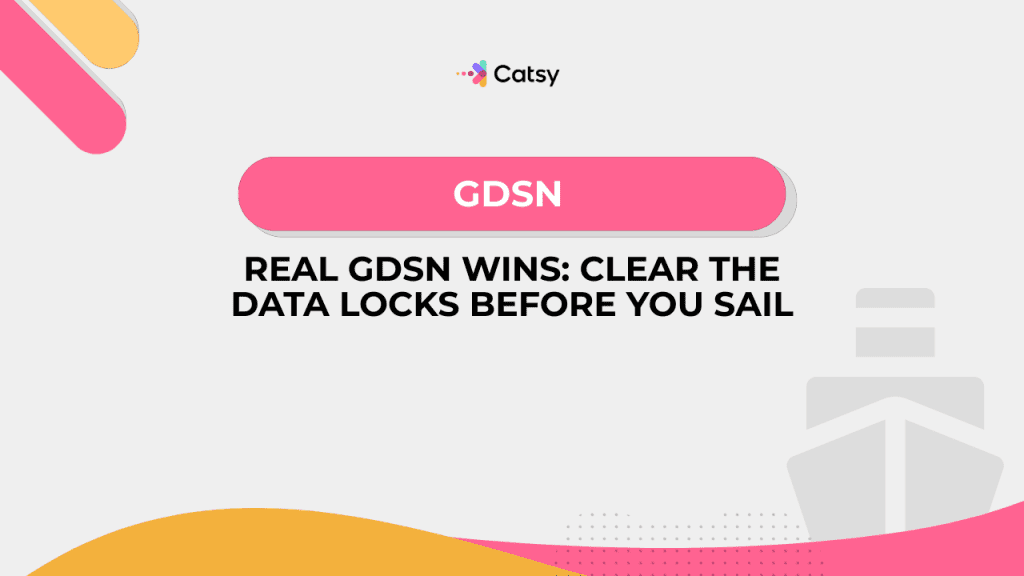
Introduction – Opening the Locks
Selling into large retailers is like moving through the locks of a busy canal system. Each lock is a critical checkpoint at which you must meet specifications before the gates will open.
Imagine your product data, now. If your data doesn’t meet GDSN (Global Data Synchronization Network) standards, your content will be stranded in backwaters – while your competition sails smoothly on.
This lock system isn’t arbitrary. It exists to manage the flow of commerce safely and efficiently. In the same way, GDSN requirements aren’t just hurdles meant to frustrate you. They represent the retail industry’s recognition that standardized product data is essential for commerce to function.
When product data flows through standardized channels, inventory systems work reliably, customer-facing information remains accurate, and supply chain operations run with precision timing that benefits everyone.
This understanding transforms GDSN compliance from a necessary evil to a strategic advantage. Our guide teaches you how to position yourself as a preferred partner.
In this Article
1. What is GDSN and Why It Matters
If your product data is your cargo, GDSN is the international maritime authority. It establishes universal standards that enable efficiency across retailers, countries, and systems. So, just as those ships must meet certain requirements to enter international waters, your product data must meet GDSN standards to enter major retail channels.
Retailer Requirements and Market Access:
The world’s largest retailers, like Walmart, Target, and Kroger, require suppliers to submit product information through GDSN-certified pools. This isn’t just a preference – it’s a requirement.
The scope of GDSN adoption is continually expanding; more and more retailers are recognizing the operational benefits of standardized data. For this reason, early compliance positions your company for growth opportunities – they may not exist today but they’ll become critical tomorrow.
Standardization Benefits and Operational Efficiency:
GDSN ensures that your core product data elements (think GTINs, weights, regulatory information, and dimensions) follow consistent formats. This standardization eliminates errors in translation, conflicting formats, and inconsistencies that are all too common with traditional exchange methods.
GDSN doesn’t just apply to your data formatting, but also includes validation rules that catch errors before they go live. This might include incorrect dimensions, invalid GTINs, or missing regulatory information. These errors are identified and fixed during submission – no more retroactive editing.
Reduced Rejections and Faster Time-to-Market:
Clean, standardized data dramatically reduces the rejection rates that plague traditional product onboarding processes. Instead of weeks or months of back-and-forth communication to resolve data issues, GDSN-compliant submissions typically process within days, enabling faster product launches and reduced time-to-market.
The validation processes built into GDSN systems catch common errors immediately, then provide you with specific feedback required to fix it. This enables super quick correction and resubmission, making your product launches and reboots fast and seamless.
Operator Prompt: Review your current product portfolio and identify which products have experienced retailer data rejections or onboarding delays in the past six months. Map these issues to specific GDSN attributes to understand where compliance improvements could have prevented problems and accelerated market entry.
Make Catsy DAM and PIM Software an Extension of Your Team
Book a Free Demo2. The Locks You Need to Clear
Each attribute addressed by GDSN functions like a specific lock gate. Missing or incorrect information stops your progress. You’ll need to return upstream, make your corrections, then try again.
Understanding each lock prevents this. Let’s take a look.
GTIN/UPC Accuracy – The Master Lock:
Your GTIN (Global Trade Item Number) is your vessel’s registration. Like a ship’s registry number, it must be unique, properly formatted, and accurately linked to your physical products. Errors can create cascading problems which impact your inventory management – and your customer experience.
The most common GTIN errors include reusing codes for different products, using SKUs instead of GTINs, and failing to update codes as packaging changes. These may seem like minor issues, but they can lead to your submissions’ rejection.
Measurements and Weights – Dimensional Compliance:
Your product dimensions (including weights) must be accurate to the decimal point, then expressed in standardized units. This information is used for warehouse automation, shipping calculations, and inventory management, so incorrect data can be quite problematic!
A package that’s slightly larger than specified might not fit in automated storage systems, while incorrect weight information can affect shipping costs and delivery promises. Dimensions are used for shelf planning, as well. Incorrect dimensions can take your products right off retail shelves.
Similarly, GDSN specifies exact units of measurement that must be used. Mixing measurement systems creates confusion and errors down the supply chain.
Regulatory Data – Compliance Gateway:
Ingredients lists, allergen warnings, nutritional information, and safety warnings are examples of critical compliance requirements. These protect retailers and consumers; if it’s inaccurate it can damage brand reputation – and possibly even lead to legal challenges.
The complexity of this required data varies widely across categories, but the accuracy standards remain high. Food products require comprehensive ingredient lists with specific formatting requirements, while electronics need safety certifications and compliance statements.
Keep in mind that your data requirements may vary by geographic market. Different countries may maintain different standards, so familiarize yourself with region-specific requirements.
Digital Assets – Visual Navigation Aids:
Consider your product images. They must meet specific resolution, content, and format requirements – just like your written content. Like a navigational chart, your images must be clear and accurate to serve as a decision making “map” for your customers.
Specific retailers will have specific requirements, but they typically include minimum resolution standards and specifications for color accuracy and background. Many will also require lifestyle shots, zoomable images, and packaging shots.
3. Preparing Your Product Data
Successful navigation through GDSN requirements starts with preparation. Like preparing a vessel for a long journey, thorough preparation prevents problems further down the channel.
Identify gaps, standardize formats, and validate accuracy before you submit your data. Here’s how.
Comprehensive Data Audit Process:
Begin with a systematic review of your existing product data. Compare it against GDSN templates and retailer specs, identifying missing information and formatting inconsistencies.
To make your process simpler, you can use actual GDSN attribute templates rather than generic checklists. These specify your exact formatting requirements, validation rules, and conditional logic – the factors that determine whether your submissions will be accepted or not.
Document each gap and create an action plan to address critical compliance issues first. You can tackle the less urgent updates in a future data audit phase.
Standardization and Format Compliance:
Establish consistent formatting standards for all of your product attributes. Similar products should use identical units, naming conventions, and data structures.
Pay particular attention to unit standardization, as mixing imperial and metric measurements or using non-standard abbreviations creates rejection risks. GDSN specifies exact unit formats that must be used consistently across all products and attributes.
As for naming conventions, pay attention to compliance with character limits, restrictions on special characters, and even language requirements.
Gap Analysis and Priority Setting:
Identify missing attributes that may cause submission blocks. Prioritize critical requirements – save the attributes that just “improve” your content for later. This prioritization enables efficient resource allocation that maximizes compliance benefits within available preparation time and budget.
As you analyze, consider both your current retailers’ requirements and anticipated ones. GDSN standards evolve constantly as market demands change. Preparing now can prevent choppy waters in the future.
Internal Process Development:
As you engage in these processes, document them for internal use. Create a style sheet for current and future teams that includes validation checkpoints, approval workflows, and regular auditing procedures.
Consider how product development, packaging, and marketing updates will impact GDSN requirements. Build these requirements into your processes – don’t treat them as a separate entity!
Tip: Even if you don’t have a sophisticated Product Information Management (PIM) system like Catsy, a well-organized spreadsheet audit using GDSN-required fields can expose critical gaps and provide a roadmap for compliance improvements.
4. Automating Checks and Validation
Are you maintaining a large catalog of SKUs? If so, automated validation systems are a game changer.
Automated validation can streamline your compliance efforts, reducing manual entry.
Automated Attribute Validation:
A modern PIM like Catsy can automatically flag missing GDSN attributes. It can also validate your data types and formats, and a PIM can map attributes for specific retail channels. These automated checks catch errors immediately rather than during submission processes.
For example, your automated validation may catch an error with your dimensions. A package’s height and width may not make sense with the entered weight – your PIM will flag this for review.
Automated validation enables continuous monitoring of compliance status… This ongoing validation is particularly valuable for organizations with frequent product updates or complex product lines that are too large for manual review.
Data Type and Format Verification:
An automated system can verify that your numeric fields contain valid numbers within acceptable ranges. It can ensure that your text fields comply with character limits. And it can verify that your date fields are formatted properly. Technical validations like these prevent submission failures caused by formatting.
The sophistication of verification varies across systems. Advanced platforms provide detailed rules, while simpler systems focus on basic compliance.
Channel-Specific Mapping and Optimization:
Advanced PIM systems can maintain channel-specific mapping that maintains GDSN compliance while making your listings picture perfect for your sales channels.
These mapping capabilities are valuable to those businesses selling through multiple retailers with different preferences. Channel-specific optimization makes your business happy, too. Maintaining core GDSN compliance, improving your customer experience, and improving your search visibility are just three benefits.
Scalability Considerations:
Even smaller businesses can use systematic validation procedures. Use spreadsheets for checklists and schedule manual reviews that use the same logical principles as an automated system. Consistency, not a fancy system, is the key.
Manual validation can be time consuming, but your system can evolve over time. You’ll benefit from templates, checklists, and standardized procedures until you feel the need to invest in a PIM.
5. Submitting to Data Pools
Once your product data meets GDSN standards, you’ll have to navigate the certified data pools that act as intermediaries between suppliers and retailers.
To do that, you’ll need to understand both data pool capabilities and submission procedures.
Data Pool Selection and Capabilities:
Which data pool supports your target retailers? Which provides the submission capabilities your business needs? Major data pools like 1WorldSync and Syndigo maintain connections with different retailer networks, for instance. But not all pools support all retailers equally well.
Evaluate data pool capabilities beyond simple retailer connections. Consider validation services, submission tracking, error reporting, and ongoing support. As you shop, you’ll notice that some pools provide enhanced validation systems while others offer minimal validation support.
You’ll also want to consider the geographic scope of your data pool. International expansion may require pools with strong connections in your target markets. The data pool landscape varies across different regions, so choose what suits your needs.
Testing and Validation Procedures:
It’s time to test!
Test your data with a small product set before you attempt a full-catalog submission. Use the feedback from your sample submissions to correct systematic errors before they go live. An incremental approach will reduce your risk – and allow you to learn!
Your testing process should include both technical validation and business process verification. That ensures that your submitted data supports your intended business outcomes.
Document the results of testing procedures, creating reference materials that guide future submissions and help new team members understand proven procedures. This documentation will become particularly valuable as teams evolve and new products are added to submission queues.
Feedback Loop Management:
Establish systematic procedures for reviewing and fixing validation errors returned by data pools and retailers. These feedback loops enable rapid correction and resubmission while providing learning opportunities that prevent similar errors in the future.
Your feedback management process should include error categorization and an analysis of the root cause. Using that information, you can implement activities to improve the process rather than just correct individual listings.
Retailer-Specific Requirements:
GDSN will give you a standardized framework, but individual retailers have unique requirements. Understand these requirements in order to enable optimized submissions to each platform.
Keep your teams current with retailer updates and communication. Submission standards evolve continuously to reflect the shifting e-commerce landscape.
Many retailers provide supplier portals, training materials, and communication channels that help suppliers stay current with evolving requirements.
6. Navigation Analogy – Understanding the Lock System
The lock system metaphor illuminates why GDSN compliance requires such precision and attention to detail. In actual canal navigation, missing one requirement—incorrect documentation, improper vessel dimensions, or inadequate safety equipment—prevents passage through the entire system, regardless of how well other requirements are met.
Sequential Gate Requirements:
Let’s compare your GDSN attributes to gates once again. Each attribute represents a sequential gate that must be cleared in order to progress to the next checkpoint. Partial completion does not equal partial progress – complete satisfaction of GDSN requirements isn’t optional.
This sequential process means that preparing 90 percent of required attributes provides no market access benefits until the remaining 10 percent are completed. Understand this reality and prioritize preparation activities and resource allocation to achieve complete compliance rather than partial improvement.
Interdependent System Design:
The lock system works because each gate depends on the last. This creates a systematic flow that manages traffic efficiently and safely. In the same way, GDSN attributes work together to create comprehensive product information that supports multiple business functions simultaneously.
Individual errors can affect business processes that seem unrelated, but recognize the interdependence. Data quality issues can create cascading problems as your business sails the channel.
Operational Efficiency Benefits:
Once your vessel has cleared each lock requirement, you can navigate freely through connected waterways. There are no persistent checkpoint delays, nor are there custom modifications for different channels.
The efficiency benefits extend beyond initial market access to include ongoing operational advantages like faster product updates, reduced maintenance requirements, and simplified expansion into new retail channels. These operational benefits often exceed the initial investment over time.
System-Wide Standards: The lock system works because all participants follow the same standards and procedures, creating predictable processes that enable efficient commerce. GDSN provides the same systematic standardization for product data, enabling efficient commerce across diverse retail channels and geographic markets.
7. Comprehensive GDSN Readiness Checklist
Are you ready to prepare for your journey? Here’s a checklist to ensure you’re addressing mandatory compliance elements and optimization opportunities.
Core Identification Requirements:
- ☐Validate GTINs using official check digit algorithms and verify uniqueness within your product line
- ☐Confirm that GTIN codes match exactly with codes printed on actual packaging
- ☐Verify that parent-child product relationships are properly structured for multi-pack items
- ☐Ensure that internal SKU numbers are properly mapped to valid GTINs for all inventory systems
Physical Specification Standards:
- ☐Measure and record all product dimensions using standardized units with the required precision
- ☐Validate package weights including both gross and net measurements where applicable
- ☐Confirm that your packaging and case pack information reflects the actual shipping and storage configurations
- ☐Verify that dimensional data is consistent with volume calculations and shipping requirements
Regulatory and Compliance Information:
- ☐Complete ingredient lists with proper formatting and allergen identification
- ☐Include all required safety warnings and regulatory compliance statements
- ☐Verify nutritional information accuracy and formatting for applicable products
- ☐Confirm country of origin and manufacturing information meets disclosure requirements
Digital Asset Standards:
- ☐Ensure that each of your product images meets minimum resolution and quality standards
- ☐Verify that image formats and file sizes comply with retailer specifications
- ☐Confirm image content accurately represents actual products without misleading elements
- ☐Include the required image types such as primary product shots, packaging images, and lifestyle contexts where specified
Data Quality and Consistency:
- ☐Standardize naming conventions and terminology across all product attributes
- ☐Verify unit consistency and eliminate mixed measurement systems
- ☐Check for completeness of all mandatory attributes for target retailers
- ☐Validate cross-attribute consistency and logical relationships within product data
Testing and Validation:
- ☐Test submissions with small product samples before full catalog deployment
- ☐Review and address all validation errors returned by data pool systems
- ☐Confirm successful data transmission and retailer acceptance for test products
- ☐Document procedures and results for future reference and team training
Ongoing Maintenance:
- ☐Establish regular audit procedures to maintain compliance as products evolve
- ☐Create update procedures for packaging changes, reformulations, and product modifications
- ☐Build compliance checkpoints into new product development processes
- ☐Monitor retailer requirement changes and update procedures accordingly
8. Measuring Success and Performance Optimization
Your GDSN compliance success extends beyond initial market access. It includes ongoing operational benefits and improvements to performance.
Quantitative Success Metrics:
Track the specific metrics that demonstrate the impact of GDSN compliance on your business. Include reduced rejection rates, time-to-market of your SKUs, and decreased customer service issues related to accuracy.
Rejection rate improvement often gives you the best overview of your success. GDSN-compliant submissions are rejected less frequently than those submitted using traditional methods. Document your rejections and track improvements over time.
Time-to-market improvements represent another quantifiable benefit. Track this, too, for both compliant and non-compliant products.
Qualitative Performance Indicators:
Monitor customer experience improvements as they’re reflected in reduced product information-related inquiries, improved product search visibility, and enhanced customer confidence in your brand.
Improvements in retailer relationships often result from GDSN compliance, as standardized data submission demonstrates professionalism and operational sophistication that differentiate preferred suppliers from those requiring additional support and oversight.
Operational Efficiency Gains:
Measure improvements in your internal efficiency. Include time spent on data correction, the number of resubmission cycles, and the decrease in manual interventions.
Standardization benefits will benefit your internal operations because your teams will develop systematic procedures. These benefits compound over time.
Competitive Positioning Analysis:
How does GDSN compliance affect your competitive positioning? Include product performance presentation, search visibility, and retailer preference.
Long-term Strategic Benefits:
Assess how GDSN compliance enables strategic opportunities like faster expansion into new retail channels, improved readiness for international market entry, and enhanced capability to support premium brand positioning through superior data quality.
Conclusion – Smooth Passage Ahead
Clearing the GDSN locks may seem like an exercise in bureaucracy, but it’s a systematic process that delivers substantial business benefits. The initial complexity gives way to routine efficiency, enabling access to valuable opportunities.
Of course, the navigation metaphor reflects the reality that GDSN compliance is about systematic execution and, ultimately, readiness. Success comes to those who understand requirements clearly and execute consistently.
With proper preparation and systematic execution, you can ensure smooth passage into any retailer’s system while building operational capabilities that support long-term business growth. The retailers who require GDSN compliance aren’t creating obstacles—they’re providing clear pathways for suppliers who demonstrate the operational sophistication necessary for modern retail partnership.
Want more tips, tutorials, and insights on product content and e-commerce operations?
Stay connected. We post regularly to help brands like yours scale smarter.
Are You Ready To streamline your product content management?
Subscribe For More Content
Sign up for monthly tips on how to drive revenue with product content.




